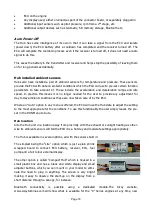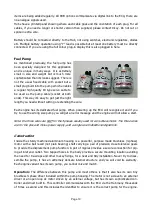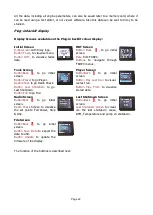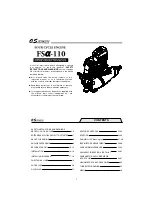
Page 32
cient, then it will be ignited in the exhaust, causing a hot start (in extreme cases a big fireball) that
surely will not hurt the engine, but can destroy the model. So:
During start-up - general
During the start-up listen to the engine sound to check for positive sound of ignition, check looking
from the exhaust that the kero is burning, or check for an increase in exhaust temperature in the
display. A small plume of white smoke from the exhaust means that the fuel is not burning. The
fuel is pooling inside the engine. Abort immediately the start.
Double check that the engine is not flooded. An extra security measure is to place a manual valve
between the fuel tank and the pump inlet, to prevent that during the process of filling the tanks or
during storage, some fuel can arrive to the engine.
After a failed start, or whatever condition that could cause that fuel be collected inside the engine
(ie accidental priming), ALWAYS empty the engine of fuel by tilting the engine nose down. Fuel will
exit through intake. Do not tilt upwards; as due at the internal engine construction the fuel cannot
exit out through the exhaust.
Kerosene can keep burning slowly for a long time inside the engine following an aborted start, if
the start-up sequence is aborted by the user or automatically before the engine arrive to idle. This
can cause that the kerosene inside the engine keep burning for long time, and could destroy the
engine or the model, if not noticed and dealt with.
IF START-UP SEQUENCE IS NOT COMPLETED, CHECK FOR FLAME INSIDE THE ENGINE.
If there is flame, then set full throttle for over 3 seconds to engage the starter and blow out the
flame. USE SHORT BURSTS OF STARTER. Using the starter for long time can overheat and destroy
the starter motor. In the case that the start-up procedure has been aborted due to starter failure
or the engine has jammed, then it will be necessary to apply the CO2 fire extinguisher. A white
smoke plume from the engine is a good indication here; mean that there is no fire inside.
First engine run
Confirm your test stand is securely fixed to a bench or heavy table. Keep your ear defend-
ers within easy reach and a CO2 fire extinguisher handy. VERY IMPORTANT ON KEROSTART EN-
GINES. Do not use a powder extinguisher, it will ruin the engine.
Fill the fuel tank. Do not forget to filter the fuel, and to mix the oil.
Confirm all batteries are freshly charged and connected up.
Check there is a temperature reading on the display.
Ensure the running area is clear of onlookers – especially the prohibited zone of a 10 metre
radius 180° arc from engine centre around the rear
Verify that the fuel tube is full of fuel and purged of all air, if not; carry out the fuel system
prime sequence after initial installation as described earlier.
While priming please observe fuel line to engine very carefully and stop as soon as fuel reaches
close to the engine. Best too short than risk flood the engine.
IMPORTANT: The prime procedure should be done only to fill the fuel tube and filter in
the case of a first installation or in case of disassembling of the tubes. It does not need









































